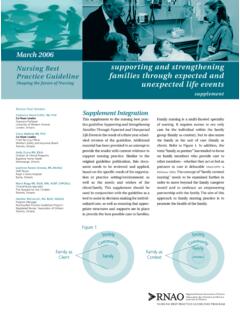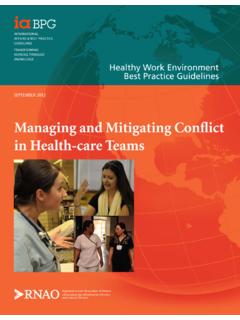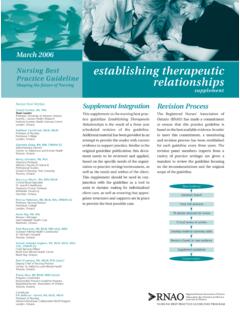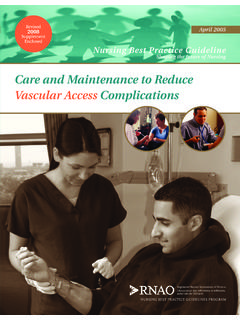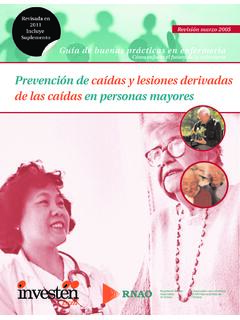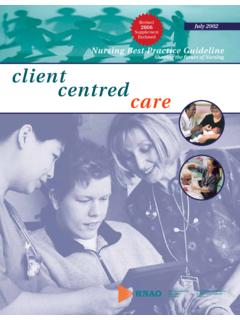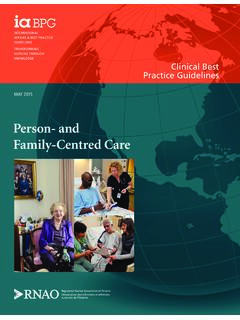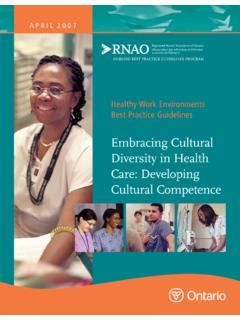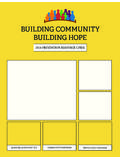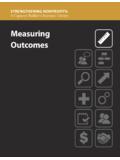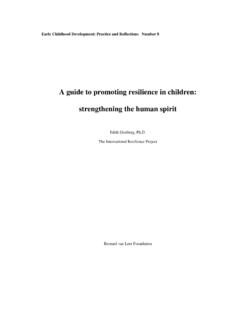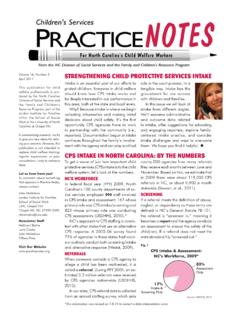Transcription of Shaping the future of Nursing supporting and …
1 Unexpected life eventsthrough expected & supporting and strengthening families Nursing Best Practice GuidelineShaping the future of NursingJuly 2002 Revised2006 SupplementEnclosedGreetings fromDoris Grinspun Executive DirectorRegistered Nurses Association of Ontario It is with great excitement that the Registered Nurses Association of Ontario (RNAO)disseminates this Nursing best practice guideline to you. Evidence-based practice supportsthe excellence in service that nurses are committed to deliver in our day-to-day practice. We offer our endless thanks to the many institutions and individuals that are makingRNAO s vision for Nursing Best Practice Guidelines (NBPGs) a reality. The Ontario Ministryof Health and Long-Term Care recognized RNAO s ability to lead this project and is providing multi-yearfunding. Tazim Virani --NBPG project director-- with her fearless determination and skills, is moving theproject forward faster and stronger than ever imagined.
2 The Nursing community, with its commitment andpassion for excellence in Nursing care, is providing the knowledge and countless hours essential to the creationand evaluation of each guideline. Employers have responded enthusiastically to the request for proposals(RFP), and are opening their organizations to pilot test the NBPGs. Now comes the true test in this phenomenal journey: will nurses utilize the guidelines in their day-to-day practice? Successful uptake of these NBPGs requires a concerted effort of four groups: nurses themselves, otherhealth-care colleagues, nurse educators in academic and practice settings, and employers. After lodgingthese guidelines into their minds and hearts, knowledgeable and skillful nurses and Nursing students needhealthy and supportive work environments to help bring these guidelines to life. We ask that you share this NBPG, and others, with members of the interdisciplinary team.
3 There is much tolearn from one another. Together, we can ensure that Ontarians receive the best possible care every time theycome in contact with us. Let s make them the real winners of this important effort!RNAO will continue to work hard at developing and evaluating future guidelines. We wish you the best for a successful implementation!Doris Grinspun, RN, MScN, PhD (candidate)Executive DirectorRegistered Nurses Association of OntarioHow to Use this DocumentThis Nursing best practice guidelineis a comprehensive document providingresources necessary for the support of evidence-based Nursing practice. The documentneeds to be reviewed and applied, based on the specific needs of the organization or practicesetting, as well as the needs and wishes of the client. Guidelines should not be applied in a cookbook fashion but used as a tool to assist in decision making for individualized clientcare, as well as ensuring that appropriate structures and supports are in place to provide thebest possible , other health care professionals and administrators who are leading and facilitatingpractice changes will find this document valuable for the development of policies, procedures,protocols, educational programs, assessment and documentation tools, etc.
4 It is recommendedthat this Nursing best practice guideline be used as a resource tool. Nurses providing directclient care will benefit from reviewing the recommendations, the evidence in support of therecommendations and the process that was used to develop the guidelines. However, it ishighly recommended that practice settings adapt these guidelines in formats that would beuser-friendly for daily use. Organizations wishing to use the guideline may decide to do so in a number of ways: Assess current Nursing and health care practices using the recommendations in the guideline. Identify recommendations that will address recognized needs or gaps in services. Systematically develop a plan to implement the recommendations using associated tools and resources will be made available through the RNAO website to assistindividuals and organizations to implement best practice guidelines.
5 RNAO is interested inhearing how you have implemented this guideline. Please contact us to share your story. 1 Nursing Best Practice Guideline2 supporting and strengthening families Through Expected and Unexpected Life EventsClaire Mallette, RN, PhD(cand.)Team LeaderChief Nursing OfficerWorkplace Safety & Insurance BoardToronto, OntarioSusie Blair, RNStaff NurseThe University of OttawaHealth Institute Cardiac SurgeryOttawa, OntarioNaomi Cornelius, RPNP rograms ManagerYorkview Lifecare CentreToronto, OntarioMargot Jeffrey, RN, BScNCare Coordinator, Child and Family TeamToronto Community Care Access Centre Toronto, OntarioLianne Jeffs, RN, MScChief of Nursing PracticeHamilton Health SciencesMcMaster University Medical Centre SiteHamilton, OntarioJudi Kauffman, RN, MSNP atient Care CoordinatorToronto Community Care Access CentreMount Sinai HospitalToronto, OntarioCathy Sharpe, RN, MNClinical Nurse Specialist, GerontologyTexas, Teplitsky, RN, MESS enior Health PlannerToronto District Health CouncilToronto, OntarioCatherine Ward-Griffin, RN, PhDAssistant Professor.
6 School of NursingFaculty of Health Sciences The University of Western OntarioLondon, OntarioDiane Williams, RN, MNAdvanced Practice NurseUniversity Health NetworkPrincess Margaret HospitalToronto, OntarioGuideline Development Panel MembersSupporting andStrengthening FamiliesThrough Expected andUnexpected Life EventsProject team:Tazim Virani,RN, MScNProject DirectorAnne Tait,RN, BScNProject CoordinatorHeather McConnell,RN, BScN, MA(Ed.) Project CoordinatorCarrie ScottAdministrative AssistantElaine Gergolas,BAAdministrative AssistantRegistered Nurses Association of OntarioNursing Best Practice Guidelines Project111 Richmond Street West, Suite 1208 Toronto, OntarioM5H 2G4 Website: Best Practice GuidelineSandra BayneFamily PracticeKanata, OntarioCareWatch Toronto Toronto, OntarioTracey Crosbie Registered Practical NurseNepean, OntarioJean JacksonExecutive DirectorInterlink Community Cancer NursesToronto, OntarioDenise McIntyreRegistered NursePre Admit Unit, the Heart InstituteOttawa, OntarioWendy MoulsdaleClinical Nurse Specialist/Neonatal PractitionerSunnybrook & Women s College HealthSciences CentreToronto, OntarioSandra PollackSocial Worker, Psychosocial Oncology ProgramUniversity Health NetworkPrincess Margaret Hospital Toronto, OntarioLinda Shaw Registered Practical NurseOttawa, OntarioFamily Support Group (anonymous)
7 Guelph, OntarioToronto District Health CouncilToronto, OntarioToronto Community Care Access CentreToronto, Ontario4 supporting and strengthening families Through Expected and Unexpected Life EventsAcknowledgementThe Registered Nurses Association of Ontario wishes to acknowledge the followingindividuals and organizations for their contribution in reviewing this Nursing bestpractice guideline, and providing valuable feedback:The Nursing best practice guideline: supporting and strengthening FamiliesThrough Expected andUnexpected Life Eventsis available on the RNAO website at sincerely acknowledges the leadership and dedication of the researchers who havedirected the evaluation phase of the Nursing Best PracticeGuidelines Project. The EvaluationTeam is comprised of:Principal InvestigatorsNancy Edwards, RN, PhDBarbara Davies, RN, PhDUniversity of OttawaEvaluation Team Co-InvestigatorsMaureen Dobbins, RN, PhDJenny Ploeg, RN, PhDJennifer Skelly, RN, PhDMcMaster UniversityPatricia Griffin, RN, PhDUniversity of OttawaResearch AssociatesMarilynn Kuhn, MHAC indy Hunt, RN, PhDMandy Fisher, BN,MSc(cand.)
8 RNAO also wishes to acknowledge the following organizations in Barrie,Ontario for their role in pilot testing this guideline:Royal Victoria HospitalSimcoe County District Health UnitEnded BeginningsContact Information Registered Nurses Association of OntarioNursing Best Practice Guidelines Project111 Richmond Street West, Suite 1208 Toronto, OntarioM5H 2G4 Registered Nurses Association of OntarioHead Office438 University Avenue, Suite 1600 Toronto, OntarioM5G 2K85 Nursing Best Practice GuidelineDisclaimerThese best practice guidelines are related only to Nursing practice and not intended to takeinto account fiscal efficiencies. These guidelines are not binding for nurses and their useshould be flexible to accommodate client/family wishes and local circumstances. They neitherconstitute a liability or discharge from liability. While every effort has been made to ensurethe accuracy of the contents at the time of publication, neither the authors nor RNAO giveany guarantee as to the accuracy of the information contained in them nor accept any liability,with respect to loss, damage, injury or expense arising from any such errors or omission inthe contents of this the exception of those portions of this document for which a specific prohibition orlimitation against copying appears, the balance of this document may be produced, reproducedand published in its entirety only, in any form, including in electronic form, for educationalor non-commercial purposes, without requiring the consent or permission of the RegisteredNurses Association of Ontario, provided that an appropriate credit or citation appears inthe copied work as follows:Registered Nurses Association of Ontario (2002).
9 supporting and strengthening FamiliesThrough Expected and Unexpected Life , Canada: Registered NursesAssociation of of Recommendations ..8 Responsibility for Guideline Development ..12 Purpose and Scope ..13 Guideline Development Process ..14 Definition of Terms ..15 Background Context ..18 Interpretation of Evidence ..20 Practice Recommendations ..22 Education Recommendations ..29 Organization & Policy Recommendations ..30 Evaluation & Monitoring ..34 Process for Update/Review of Guideline ..35 References ..36 Bibliography ..39 Appendix A - Components of Family Assessment Models and Tools ..42 Appendix B - Sample Questions for Key Areas of Family Assessment ..43 Appendix C - Toolkit: Implementation of Clinical Practice Guidelines ..46 Appendix D - The Flower (Em)power Pocket Card ..4 Nursing Best Practice GuidelineThe RNAO Consensus Panel (2000) for this Nursing best practice guideline formulated aframework based on the best practice guideline process.
10 The framework is called Flower(Em)power and is depicted in Figure 1 on the following page:This framework depicts a comprehensive and perennial approach to best practices in thisarea. At the core of the flower is the nurse-family partnership. Without a genuine partnership,the four petals of the flower are unable to blossom and are of limited value to the familythrough expected and unexpected life events. The four petals are: Assess family need; Sustain a caring environment; Identify resources and support; and Educate and provide a caring environment represents different interrelated components of promotingfamily health. The stem of the flowersymbolizes the advocacy activities and policychangesneeded to ensure that the Nursing activities that support and strengthen families can growand flourish. The leaves of the flower- vision, values and principles- are the source of a bur-geoning model of supporting and strengthening families .
